Sex differences in apoptosis do not contribute to sex differences in blood pressure or renal T cells in spontaneously hypertensive rats
- PMID: 36304583
- PMCID: PMC9592703
- DOI: 10.3389/fphys.2022.1006951
Sex differences in apoptosis do not contribute to sex differences in blood pressure or renal T cells in spontaneously hypertensive rats
Abstract
Apoptosis is a physiological and anti-inflammatory form of cell death that is indispensable for normal physiology and homeostasis. Several studies have reported aberrant activation of apoptosis in various tissues at the onset of hypertension. However, the functional significance of apoptosis during essential hypertension remains largely undefined. The current study was designed to test the hypothesis that apoptosis contributes to sex differences in blood pressure and the T cell profile in spontaneously hypertensive rats (SHR). Apoptosis was measured in kidney, aorta and spleen of 13-week-old adult hypertensive male and female SHR. Female SHR had greater renal and aortic apoptosis compared to age-matched males; apoptosis in the spleen was comparable between the sexes. Based on well-established sex differences in hypertension, we tested the hypothesis that greater apoptosis in female SHR contributes to the lower BP and pro-inflammatory profile compared to males. Male and female SHR were randomized to receive vehicle or ZVAD-FMK, a cell permeable pan-caspase inhibitor, in established hypertension from 13 to 15 weeks of age or at the onset of hypertension from 6 to 12 weeks or age. Treatment with ZVAD-FMK lowered renal apoptosis in both studies, yet neither BP nor renal T cells were altered in either male or female SHR. These results suggest that apoptosis does not contribute to the control or maintenance of BP in male or female SHR or sex differences in renal T cells.
Keywords: cell death; gender; inflammation; kidney; necrosis.
Copyright © 2022 Abdelbary, Mohamed, Gillis, Diaz-Sanders, Baban, Brands and Sullivan.
Conflict of interest statement
The authors declare that the research was conducted in the absence of any commercial or financial relationships that could be construed as a potential conflict of interest.
Figures
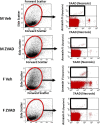


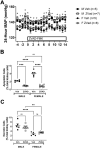
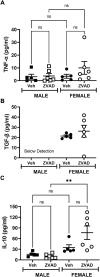


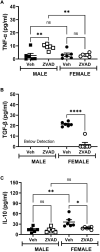

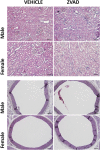
Similar articles
-
Necrosis Contributes to the Development of Hypertension in Male, but Not Female, Spontaneously Hypertensive Rats.Hypertension. 2019 Dec;74(6):1524-1531. doi: 10.1161/HYPERTENSIONAHA.119.13477. Epub 2019 Oct 28. Hypertension. 2019. PMID: 31656095 Free PMC article.
-
Female spontaneously hypertensive rats have a compensatory increase in renal regulatory T cells in response to elevations in blood pressure.Hypertension. 2014 Sep;64(3):557-64. doi: 10.1161/HYPERTENSIONAHA.114.03512. Epub 2014 Jun 9. Hypertension. 2014. PMID: 24914200 Free PMC article.
-
Sex differences in TLR4 expression in SHR do not contribute to sex differences in blood pressure or the renal T cell profile.Am J Physiol Regul Integr Comp Physiol. 2022 Apr 1;322(4):R319-R325. doi: 10.1152/ajpregu.00237.2021. Epub 2022 Feb 2. Am J Physiol Regul Integr Comp Physiol. 2022. PMID: 35107023 Free PMC article. Clinical Trial.
-
Splenectomy increases blood pressure and abolishes sex differences in renal T-regulatory cells in spontaneously hypertensive rats.Clin Sci (Lond). 2021 Oct 15;135(19):2329-2339. doi: 10.1042/CS20210469. Clin Sci (Lond). 2021. PMID: 34585239
-
Sex differences in T cells in hypertension.Clin Ther. 2014 Dec 1;36(12):1882-1900. doi: 10.1016/j.clinthera.2014.07.011. Epub 2014 Aug 16. Clin Ther. 2014. PMID: 25134971 Free PMC article. Review.
Cited by
-
Persistent Renal Oxidative Stress Despite Mannitol Nephroprotection: The Impact of Social-Single Prolonged Stress in Male and Female Rats Exposed to Cisplatin.Cell Biochem Funct. 2025 Jul;43(7):e70101. doi: 10.1002/cbf.70101. Cell Biochem Funct. 2025. PMID: 40626517 Free PMC article.
References
Grants and funding
LinkOut - more resources
Full Text Sources

